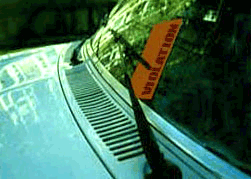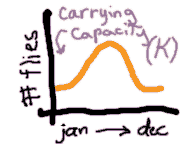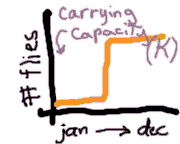Applet: Seasonal changes
"Was that banana good to the last bite?" I asked, all innocent-like. "Oh, yes," she answered dreamily, "The last part was especially mush..." she stopped short. I smiled the cold toothy grin of a tiger with his paw on its prey. "You ate the last of the banana, didn't you?" Her eyes narrowed, all 800 units. "Of course I did," she spat. It wasn't pretty. "Why shouldn't I?" "What about your kids?" "What did I owe those ingrates?! Did they ever write? Did they ever e-mail except to ask for more honey?" |
 Just to round out your detecting skills, we'll talk about 2 other ways that the assumptions of the exponential growth model might be violated. But we won't go into the math so much for either of these.
Just to round out your detecting skills, we'll talk about 2 other ways that the assumptions of the exponential growth model might be violated. But we won't go into the math so much for either of these.
An assumption violated, or:
Who says carrying capacity should stay constant?
When I first talked about carrying capacity, I made it sound like a fixed, immutable quantity, like an egg carton with a dozen eggs, for example. But that's not necessarily true. Lots of factors might affect how many flies can survive in a given environment, including how much food is available and how warm it is. Seasonal effects are especially common. Flies prefer temperatures in the 90s, but they can still fly at 53 degrees. At 48 degrees they're reduced to a crawl, and at 44 degrees they're virtually comatose. On the other hand, if the temperature climbs past 102 degrees, heat paralysis sets in, and at 116
degrees, they die whether or not you swat them. So if you graphed seasonal carrying capacity over time, it would have a hump during the summer:

Alternatively, maybe I suddenly decide I love bananas and I start buying bags every week. Then carrying capacity might increase like a "step-function": 
In this applet, you can see what happens when the carrying capacity changes over time in a variety of ways. Click the first button to change carrying capacity over the year. Then click the second button to watch dynamics change.
Copyright University of Maryland, 2007
You may link to this site for educational purposes.
Please do not copy without permission
requests/questions/feedback email: mathbench@umd.edu